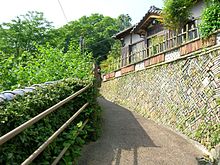- Not to be confused with Seto Inland Sea.
Seto (瀬戸) in Northern Aichi prefecture is synonymous with ceramics in Japan. This city is home to several ceramic artists and companies.
Understand
edit
Seto has a long history of ceramics. In Japan, the term Setomono (瀬戸物. lit. Seto's things) means ceramics.
During the Edo period, Tamikichi Kato (加藤民吉), brought new methods of ceramic production to Seto and founded his own style. Eventually the domain of Owari became his patrons which allowed his style to flourish. As such, he is considered to be the father of Seto ceramics.
Tourist information site
editThe local tourist association has a partly multilingual guide site.
Get in
editBy train
editSeto is home to two train lines, the primary being the Meitetsu-Seto Line. This train is easily recognizable by its bright red paint job. It runs regularly between Owari-Seto and Sakae.
If coming from Nagoya station there are two ways to reach Seto. The first way you start out on the JR Chuo Line to Ozone. At Ozone you change from JR to the Meitetsu and you take the Meitetsu to Seto. The second way is to again take the JR Chuo Line, but instead of disembarking at Ozone continue riding to Kozoji station. At Kozoji change to the Aichi Loop Line and get off at Shin-Seto.
Please note that most of the sites and ceramics shops are located near Owari-Seto station and not Shin-Seto.
Get around
editSee
editSeto was part of the location of the Expo 2005 held in Seto and Nagakute. The attractions are mostly gone, but the grounds are still there and have been converted into a park.
Museums
edit- 1 Aichi Prefectural Ceramic Museum (愛知県陶磁美術館), 234 Minamiyamaguchi-cho, ☏ +81 561-84-7474. Tu-Su 09:30AM-16:30. Temporarily closed for renovation until April 2025. This museum is home to a large collection ancient works of the Jomon era and ancient ceramic kilns. It can be reached by taking a Meitetsu bus from Owari-Seto Station to Touji Shiryoukan.
- 2 Seto Ceramics and Glass Art Center (瀬戸市新世紀工芸館), 81-2 Minami-Nakanokiri-cho, ☏ +81 561-97-1001. Th-Tu 10:00-18:00. This small art center has a delightful display of glass and ceramic art made by local artists. It also sports a nice cafe.
- 3 Setogura Museum (瀬戸蔵ミュージアム), ☏ +81 561-97-1190. Great museum with several ceramic exhibits and a reproduction of old Seto. Adults ¥500, high school and college students ¥300, children free.
Shrines
edit- 4 Kamagami Shrine (窯神神社) (On a steep hill 5-10 minutes' walk behind Owari-Seto Station.), ☏ +81 561-82-7111. This shrine dedicated to the founder of Seto ceramics, Tamakichi Kato, and yields a nice view of the city. There is also a monument dedicated to those from Seto who died during the Second World War.
Do
edit

- Kurufuku Manekineko Festival in Seto (来る福招き猫まつりin瀬戸). Usually held Sep 29. This is a festival for the "manekineko" or the beckoning cat which can be seen in almost every shop, restaurant and other retail area. Hundreds of these statues are put on display and other exhibits can be seen as well.
- Setomono Festival (せともの祭). The second Sa and Su of Sep. Ceramicists of the city and other regions turn out to sell their wares at a discount price. There are thousands of pieces that can be bought for almost any purpose. Great place and time to get authentic Japanese souvenirs.
- Iwayado Park (岩屋堂公園) (On the outskirts of Seto.). This park is a nice getaway from the hustle and bustle of traveling and museum hopping. There is a nice river flowing through the park which makes for a nice dip in the summertime or great atmosphere for autumn colors or cherry blossom viewing.
- Kasen Studio (霞仙) (take a bus from behind Owari-seto Station towards Akazu (赤津), get off at Oomatsu (大松)and follow the signs to Kasen (窯元霞仙)). This studio offers pottery making experience classes for both pottery making on the wheel and pottery painting. Classes are conducted in small groups, and studio owner can speak decent English.
Buy
editCeramics can be found in many of the shops that line the main street of Owari-Seto. Ceramics and glass works can be also purchased in the Seto Ceramics and Glass Center.
- Seto Ginza Shopping Street (せと銀座通り). Named after the famed district in Tokyo this small and quaint street offers a look into pre-shopping mall Japan. It's got several restaurants and old fashioned shops. If you're interested in getting Japanese style items or green tea soft serve ice cream, this is the place to go.
Eat
edit- Kinchan (金ちゃん) (go down the stairs from Shin-Seto Station, take a right, go about 50 meters, and this corner bar will be on your left). This is a great little izakaya (Japanese style bar). Arrive around 17:00, as it gets crowded quickly. Try the yakitori and the chicken hearts.
- Parti Seto (パルティ瀬戸) (next to Owari-Seto Station). Numerous restaurants. If you're not sure where to go or are just tired from touring you should try this place.
- Daifukuya (大福屋) (on Ginza Shopping Street away from the station), ☏ +81 561-84-3894. Th-Tu. This small shop serves up nice yakisoba. ¥500 and up.
- Apita (アピタ瀬戸店) (across from Owari-Seto Station). This large grocery store has prepared meals, and there's a food court with several restaurants inside, too.


